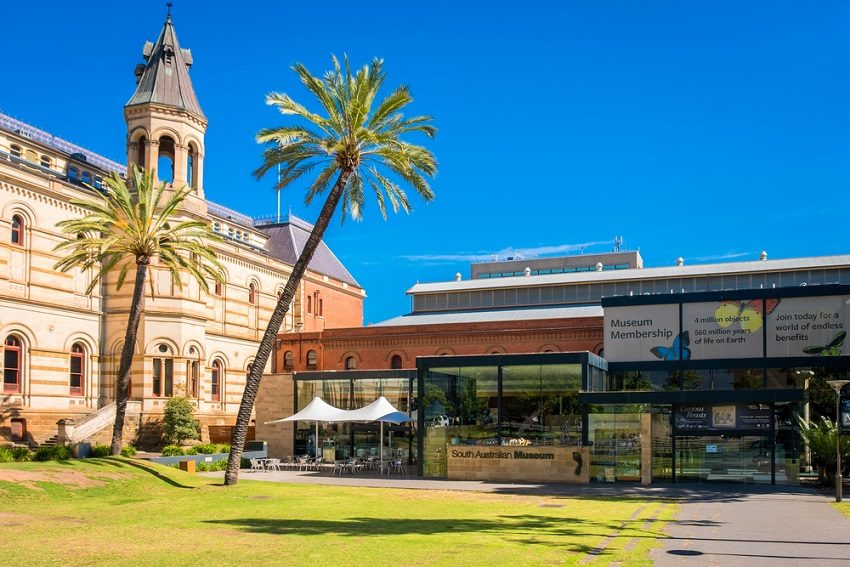Transforming the South Australian Museum

A proposed new site to store, promote and share the South Australian Museum’s Aboriginal collections would help define Adelaide as a year-round destination for national and international visitors interested in Aboriginal art and culture.
Museums are our memory banks. The South Australian Museum is the custodian of some of the most important cultural and scientific collections in the world. We can tell the story of life in Australia going back 600 million years, the story of Aboriginal Australia going back 60,000 years, and of the social and ecological change that has unfolded across our continent since Europeans arrived only 230-odd years ago. Our archival materials pertaining to Aboriginal Australia are listed in the UNESCO Memory of the World. Our collections are invaluable, the stories they can tell us even more so.
Museums need to care equally for all their collections. But some collections demand more of us. Right now, for us at the South Australian Museum, it is our Australian Aboriginal cultural collections requiring urgent attention. These are the most representative and important of their kind in the world, cataloguing the resilience and ingenuity of the First Australians: the oldest continuous living culture on the planet today. We have a boomerang twice as old as the pyramids.
This not just an important collection on local or national terms; this is a collection of global significance. It tells stories about Australia, and about our world, no other collection can tell.
These Aboriginal collections are at the core of South Australia’s state heritage. Our vision is a new policy idea to develop a landmark piece of cultural infrastructure: a new site in Adelaide to store, promote and share the state’s heritage currently in storage and not publicly accessible. It could be the most important shift in thinking at the South Australian Museum since the museum was created 160 years ago.

This year’s popular exhibition Yidaki: Didjeridu and the Sound of Australia was evidence of the potential for the Museum’s enormous collections (photo: Alex Robertson)
Currently, only five per cent of the 30,000-strong collection of Aboriginal art and artefacts is on display. Ninety-five per cent of the greatest story on the planet is currently unreadable, sitting silently on shelves. A new facility with areas of open-storage would turn the Museum inside-out: protecting the state’s heritage while simultaneously making Aboriginal heritage a focus in the cultural landscape of Adelaide.
There is a potential to realise this policy proposal in an innovative partnership with the state, Aboriginal organisations and communities, philanthropists and developers. South Australia is a leader in exploring new political relationships with Aboriginal people. This new site could be a concrete symbol of that renewed commitment.
The model for this proposal is not pre-determined. The Museum is contemplating a future that is responsive to Aboriginal authority and would benefit from being designed in close consultation with Aboriginal people. There is a lot more work to be done to see if this can be realised.
Whatever its final form, the initiative could provide ground-breaking opportunities to explore the big questions of cultural custodianship in Australia, opening the way for new models of shared management and Aboriginal governance. The Museum would work with South Australian communities to explore innovative and contemporary options for managing the facility and for providing education, training and employment opportunities for Aboriginal people.
The centre could also become a hub for the digital future of the museum in ways our current facilities never can: working with cutting edge technologies to both conserve our collections and reimagine the global possibilities of research and access. This would transform the possibilities of visitation and scale of our audience: physically turning the museum out to face South Australians, while virtually turning our heritage out to face the world. The world’s most important collection of Aboriginal culture would finally have the audience it deserves.

As with Yidaki, Aboriginal communities and leaders must be involved in new initiatives, says Carty (photo: Alex Robertson)
Our Museum recently won the South Australian Tourism Award as the state’s premier cultural destination. This proposal would allow South Australia to effectively promote itself not only as the geographic gateway to Central Australia — but as the cultural gateway to Aboriginal Australia. In concert with the TARNANTHI Festival, the centre would help define Adelaide as a year-round destination for national and international visitors interested in Aboriginal art and culture.
* * * * *
Museums are our memory banks. They tell us where we have come from. They also allow us to imagine where we are heading. These collections are calling us out. Maybe this is their purpose, their challenge to us all.
For they are not simply the Museum’s collections; they are the state’s collections. They are collections held in trust for us, and collections that we now hold in trust. This is the most important idea most of us will ever work on, because it is not simply about how we care for Museum collections, or celebrate Aboriginal culture, it’s about how we value it. It is therefore about how we cultivate the values of a mature Australian culture.
What we do now as custodians of these collections, in true partnership with Aboriginal people, is a statement of intent, the legacy of which will be felt for generations.
Professor John Carty is the Head of Anthropology at the South Australian Museum.
The Adelaide Review is a media partner of the South Australian Museum.